Effective immediately masking is required for everyone when present on all inpatient units, in the Emergency Department (ED), the Urgent Care Centre (UCC), and the Children’s Outpatient Centre (COPC).

At KHSC, the stem cell transplant team is using cellular therapy to support patients with certain types of blood cancers that would otherwise be difficult to treat. By retrieving, preserving, and reintroducing a patient’s own stem cells back into their body, patients with myeloma and lymphoma can be treated with more aggressive chemotherapy, resulting in better outcomes.
Health care teams often look to systemic treatments, like chemotherapy, to destroy cancer cells and shrink tumors. Chemotherapy is designed to deliver maximum impact to cancer cells, but it also damages healthy cells. Because of this, there is a limit to how “aggressively” a cancer can be treated.
The patients that are referred to for a stem cell transplant have been diagnosed with either a lymphoma that has returned, or multiple myeloma. These cancers are notoriously difficult to treat, and often times need high dose of specific chemotherapy that can do damage to the patient’s bone marrow. It would take months for the patient’s bone marrow to recover on its own. Without the collection of the hematopoietic stem cells, cells that have the ability to grow into any type of blood cell, it would be unsafe for the patients to receive this chemotherapy. Thus, these cells are used as a rescue for these patients.
Expanding the treatment threshold
At KHSC, the Cancer Centre’s malignant hematology unit practices a specific type of transplant that reintroduces a patient’s own stem cells — known as an “autologous” donation.
Here’s how they do it:
- Patients are given medications that cause the Bone marrow to create more white blood cells, and in creating more white blood cells it has to make a lot of stem cells. These stem cells spill out of the bone marrow into the circulating blood where the nurses are able to collect them.
- Cells are collected, using a process known as “apheresis.” The patient is connected to an machine where the blood is pulled from the body and separated in a centrifuge. The stem cells are skimmed off and the rest of the blood is returned to the body.
- The stem cells are sent to Ottawa for processing and are then frozen at a temperature of at least -180 degrees celcius, until they are needed.
- Once the patient has been deemed safe to proceed with transplant by the health care team, they are admitted for high-dose chemotherapy. This chemotherapy is very effective at getting rid of the last little bits of disease that may still be present in the patient’s blood, but it is also very hard on the bone marrow.
- Once the chemotherapy has been cleared from the patients’ blood stream, it is safe to give the stem cells back to the patient via a transfusion. The cells are thawed at the patient’s bedside and are reintroduced back into the body.
Th entire process usually takes about seven to 10 days, and the patient is at a very high risk of infection during this time, as they have no immune system to help fight off any invading germs or bacteria, so they are closely monitored by the healthcare team.
The success rate for this procedure varies based on individual circumstances, and not every patient is a good candidate for this treatment. However, some patients with lymphoma may be completely cured, while others with myeloma may be in remission for extended periods of time which improves their quality of life.
Of all patients treated by the stem cell program at KHSC, 65 per cent have myeloma, 34 per cent have lymphoma and one per cent have other solid germ cell cancers.
It takes a dedicated team to complete this process, including seven nurses, three physicians and two nurse practitioners, registered nurses, social workers, physiotherapists, dieticians and pharmacists, all of whom are supported by quality assurance teams, program managers, a clerical secretary and data analysts.
To be successful, the process needs to be perfectly executed, which is why the program is also FACT accredited. It ensures that they’re applying the highest standard of clinical practice, meaning safer treatments for patients.
This is the place...
The KHSC program is one of six stem cell transplant centres in Ontario, and one of only five sites that offers full services (from referral to consult, collection and transplant). The program performs between 70-80 stem cell collections, and 50-55 transplants each year (sometimes patients need more than one collection to obtain cells).
As part of the Southeast Regional Cancer Program, it provides services along the corridor between Trenton and Smiths Falls, meaning that these patients don’t need to drive to Toronto or Ottawa to receive care. But the KHSC program is also supporting programs across the province that may be over capacity. 42 per cent of patients treated by the program are from outside of the region.
The stem cell program is an example of how collaboration, innovation and a commitment to excellence is coming together to improve patient care at KHSC. As research continues to unravel the intricacies of stem cell biology and cancer care, new advancements like are always on the horizon.



